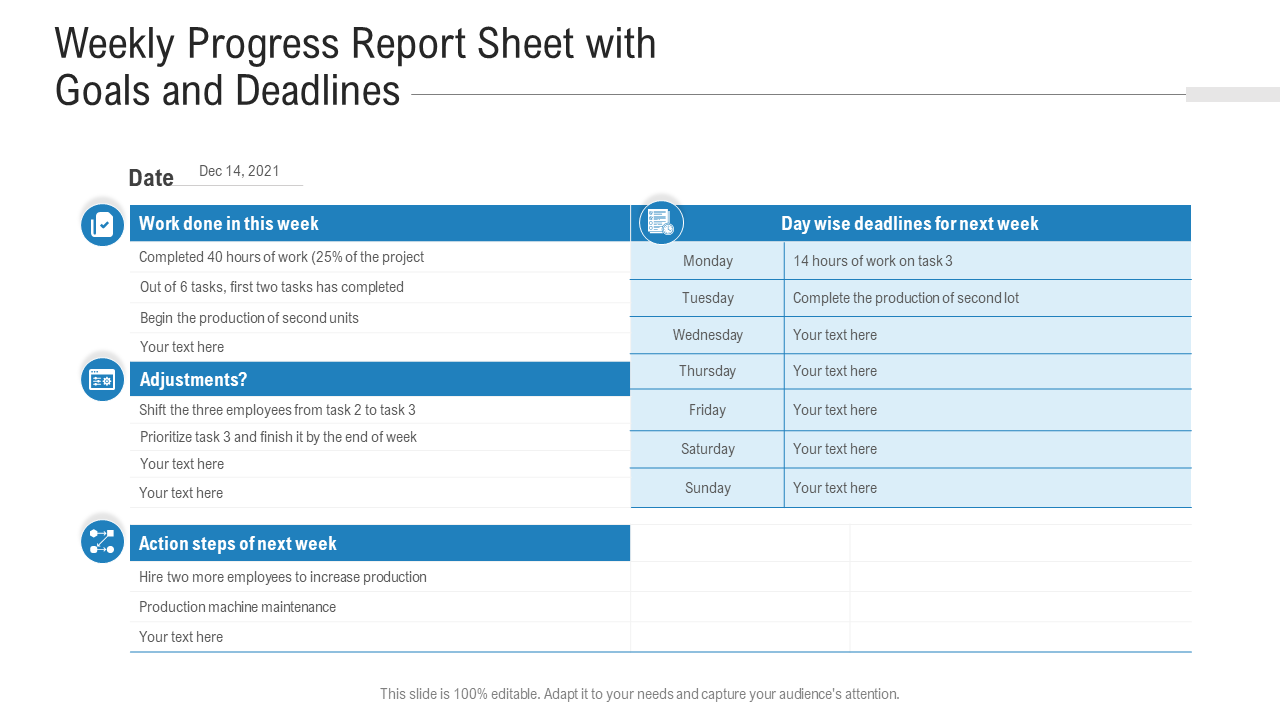Success is the sum of small efforts repeated day in and day out.
- Robert Collier
In business, success is not achieved overnight or through grand gestures alone. It is the cumulative result of consistent, small efforts made over time. By breaking down long-term objectives into smaller, achievable milestones, businesses can focus on the incremental progress they need to make each week.
Weekly goals serve as a framework for organizing and prioritizing these small efforts. They offer a precise roadmap and direction for the duties that must be carried out to succeed. Working everyday towards these goals ensures progress, even if it may seem small in the short term. This iterative approach allows businesses to build momentum, learn from their failures, and make necessary adjustments. The implementation of weekly goals also supports the development of good habits and routines within a business. By consistently striving to achieve these goals, companies establish a rhythm of productivity ingrained in their operations.
SlideTeam’s weekly goals templates offer a comprehensive solution for professionals seeking to boost their productivity, stay focused, and achieve their targets. Whether you are working independently or with a team, optimize performance, keep tabs on the progress, and achieve milestones with our content-ready weekly goals templates. These actionable PowerPoint templates are valuable to propel your goals and efforts to new heights.
Without further ado, let’s get started.
Template 1: Weekly Progress Report Sheet with Goals and Deadlines
Share the collaborative effort of your team and their progress with our ready to use PowerPoint template. Deploy this pre-designed PowerPoint slide and highlight your company’s goals, deadlines for the workforce, performance evaluation. This flexible PPT diagram also comprises a section on action plan for the coming weeks to streamline priority tasks and business functions. Present tasks completed, milestones achieved, and any potential obstacles encountered using this PowerPoint template.
Template 2: Effective Weekly Time Schedule to Achieve Business Goals
This template defines a structured framework for allocating time to various business activities and tasks. Leveraging appealing design to define high-priority tasks and tentative deadlines to help employees emphasize the critical activities. This is a top-notch PowerPoint template that showcases top goals, things to-do, and notes to keep the seniors, stakeholders, and everyone on the team on the same page. Use this PowerPoint slide to assess the progress and raise concern if you see any gaps or loopholes in the process.
Template 3: Sales Activity Tracking with Weekly Goals
This well-structured template allows you to track sales activities, such as calls made, emails sent, meetings scheduled, presentations delivered, deals closed, etc. It will enable your team to log their activities and record their efforts. This slide also provides space for notes and observations, where you and your team can document essential details about prospects, client feedback, etc. Download it now to track weekly sales goals progress.
Streamline Your Workflow, Maximize Productivity, and Skyrocket Your Results
Employ our weekly goals templates to seize opportunities, exceed targets, and celebrate record-breaking success.
PS: If you want to achieve sales mastery, check out our dynamic one-page weekly goal templates guide.
FAQs on Weekly Goals
What are some goals for the week?
Some goals for the week include boosting employee productivity, enhancing collaboration, and promoting employee engagement. The first goal could involve implementing strategies to optimize workflow processes, such as streamlining communication channels or providing employees with the necessary resources and tools. Encouraging collaboration could be another objective to foster teamwork and idea-sharing among employees, leading to innovation and improved problem-solving.
How do you arrange weekly goals?
Arranging weekly goals in a business involves a systematic approach to ensure they are defined, communicated, and tracked with ease. Here's a step-by-step process:
- Identify Key Objectives: Start by identifying the business’s key objectives. These goals should align with the overall company strategy and long-term goals.
- Break Down Objectives: Break down the critical objectives into smaller, actionable goals that can be achieved within a week. Ensure these goals are specific, measurable, attainable, relevant, and time-bound (SMART).
- Prioritize Goals: Determine the priority of each goal based on its importance and urgency. Consider the impact on the business and the alignment with the current business needs.
- Assign Responsibility: Assign responsibilities for each goal to the appropriate individuals or teams. Communicate the expectations and deadlines associated with each plan.
- Set Key Performance Indicators (KPIs): Define specific metrics or KPIs to measure the progress and success of each goal. These metrics should be quantifiable and aligned with the objectives.
- Communicate and Align: Communicate the weekly goals and associated responsibilities to all relevant employees. Ensure everyone understands the plans, roles, and how they contribute to the business objectives.
- Monitor and Track Progress: Regularly monitor and track the progress of each goal throughout the week. Use project management tools, dashboards, or regular check-ins to keep everyone updated and accountable.
- Adjust and Adapt: As the week progresses, be open to adjusting and adapting the goals based on emerging needs, challenges, or opportunities. Flexibility is critical to ensure the goals remain relevant and achievable.
- Evaluate and Learn: At the end of the week, evaluate the achieved results and reflect on the lessons learned. Identify any areas for improvement in goal-setting and execution processes.
Why are weekly goals important?
Weekly goals are essential for several reasons:
- Focus and Clarity: Weekly goals provide focus and clarity to employees by breaking down long-term objectives into smaller, achievable targets.
- Priority Setting: By identifying the most critical tasks for the week, businesses can ensure that their limited time, energy, and resources are allocated to the domains that will have the most significant impact on the organization's overall success.
- Motivation and Engagement: Setting weekly goals creates a sense of purpose and inspiration among employees. Employees with clear goals are more likely to feel engaged, challenged, and motivated to perform their best.
- Alignment and Coordination: When everyone in the company works towards specific goals that are in line with the overarching strategy, it promotes coordination, collaboration, and synergy among team members.
- Progress Tracking and Accountability: Weekly goals provide a framework for tracking progress and holding employees accountable.
- Agility and Adaptability: Weekly goals allow agility and adaptability in a fast-paced business environment. By setting goals on a weekly basis, businesses can respond to changing circumstances, emerging opportunities, or unexpected challenges.





 Customer Reviews
Customer Reviews



















